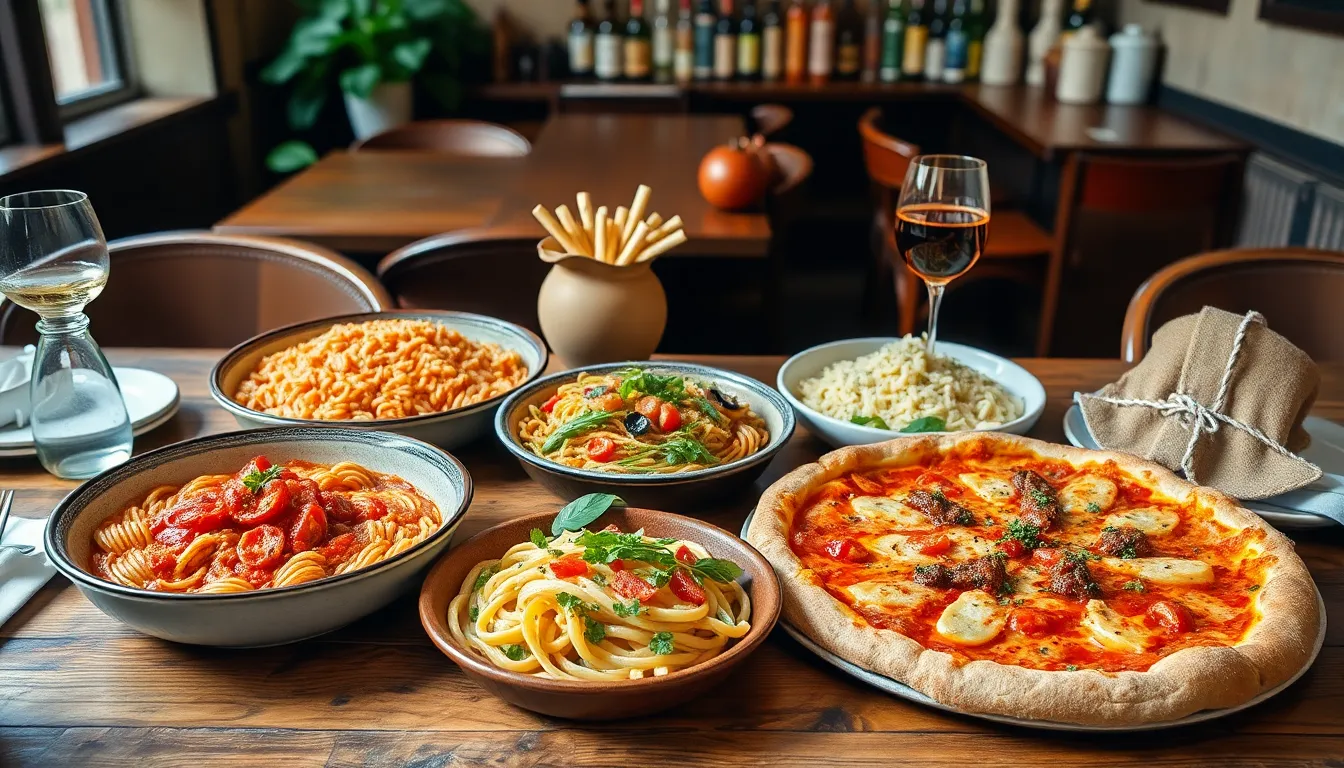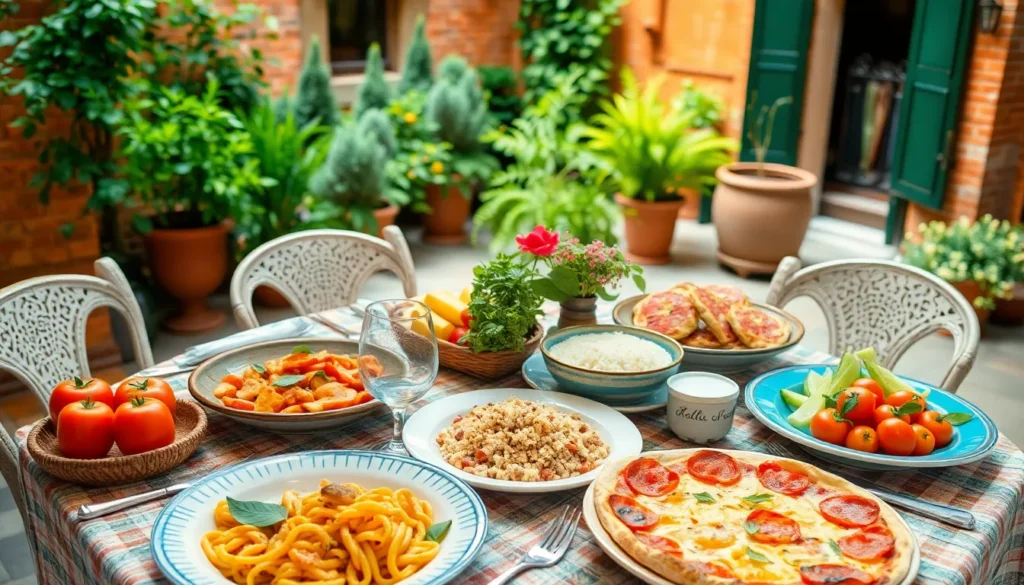When it comes to Italian cuisine, the mere mention of pasta can make taste buds dance like they’re at a lively piazza. From rich, creamy risottos to zesty pizzas topped with everything from classic margherita to adventurous truffle oil, Italy serves up a culinary experience that’s hard to resist. It’s not just food; it’s a love affair that starts with a simple “mangia” and ends with a satisfied sigh.
Table of Contents
ToggleOverview of Italian Dishes
Italian cuisine offers a variety of iconic dishes that speak to its rich culinary tradition. Pasta takes center stage with a broad range of shapes and sauces, with classics like spaghetti carbonara and lasagna capturing attention. Risotto, often savory and creamy, showcases the versatility of Arborio rice combined with seasonal ingredients.
Pizzas highlight regional preferences, with margherita pizza celebrated for its simplicity and fresh ingredients. Innovative toppings such as truffle oil elevate modern interpretations, appealing to adventurous eaters.
Vegetable-based antipasti serve as perfect starters, offering marinated artichokes and roasted peppers. Classic dishes often incorporate fresh herbs like basil and parsley, enhancing the overall flavor profile.
Desserts, including tiramisu and panna cotta, provide a sweet finish to any meal. Gelato serves as a popular alternative to traditional ice cream, with intense flavors that reflect local produce.
Every meal in Italian culture revolves around sharing and savoring every bite, creating a communal atmosphere. Regional diversity plays a significant role, as each area has its unique specialties and cooking techniques. Understanding these elements enriches the dining experience, revealing the passion embedded in Italian food.
Popular Regional Italian Dishes

Italian cuisine boasts a wide range of regional dishes, each with unique ingredients and flavors. Exploring these specialties reveals the depth of Italian culinary traditions.
Northern Italian Specialties
Northern Italy features dishes rich in cream and butter. Risotto alla Milanese highlights saffron’s distinct flavor, while polenta serves as a comforting staple. Pesto Genovese pairs basil with pine nuts, producing vibrant sauces that complement pasta. Lasagna al Forno showcases layers of pasta and béchamel, reflecting its Emilian roots. These specialties emphasize fresh ingredients and regional variations, creating a unique tasting experience.
Southern Italian Classics
Southern Italy shines with fresh vegetables and bold flavors. Pizza Napoletana, originating from Naples, is known for its thin crust and simple toppings. Pasta alla Puttanesca combines tomatoes, olives, and capers, demonstrating robust Mediterranean influences. Caponata, a sweet and sour eggplant dish, captures distinct Sicilian tastes. These classics highlight the warmth and passion of Southern Italian cooking, making each dish a celebration of local ingredients.
Cooking Techniques in Italian Cuisine
Italian cuisine employs a variety of cooking techniques that showcase its rich flavors and regional diversity. Traditional methods often celebrate simplicity, allowing high-quality ingredients to shine.
Traditional Methods
Braising ranks among the most cherished Italian techniques. This slow-cooking method enhances the flavors of meats like osso buco and ensures tenderness. Another classic is sautéing, used frequently for vegetables and seafood, creating depth while preserving texture. Additionally, boiling pasta remains a vital skill. Chefs know to cook pasta in salted water until al dente for optimal results. Roasting vegetables and meats in the oven brings out natural sweetness and adds a charred flavor, a technique often seen in rustic Italian dishes. Steaming also finds its place in preparations like tortellini, maintaining vibrant colors and nutrition.
Modern Adaptations
Modern adaptations embrace innovation while respecting tradition. Sous-vide cooking, for instance, offers precise temperature control for meats, resulting in unmatched tenderness. Similarly, pressure cooking speeds up preparations without sacrificing flavor. Additionally, the use of spiralizers allows chefs to create vegetable pasta alternatives, catering to health-conscious diners. Wood-fired ovens gain popularity beyond pizzerias, providing a distinct smoky flavor to various dishes. Moreover, contemporary Italian chefs often integrate global influences, blending traditional recipes with international ingredients. These modern techniques reflect the evolving nature of Italian cuisine while retaining its core essence.
Essential Ingredients in Italian Cooking
Italian cooking relies on fresh, quality ingredients that define its rich flavors and textures. Essential components create the essence of beloved dishes, emphasizing the importance of using the right elements.
Common Herbs and Spices
Basil plays a critical role in many Italian recipes, lending its sweet aroma and flavor to sauces and salads. Oregano is a favorite, particularly in tomato-based dishes and pizzas, adding depth to the overall taste. Parsley, often used as a garnish, brings a fresh finish to various plates. Rosemary and thyme contribute earthy notes, enhancing roasted meats and vegetables. Garlic serves as a foundation, infusing oils and sauces with its distinctive bite. Each herb and spice fulfills a unique purpose, elevating Italian dishes and creating unforgettable culinary experiences.
Key Pantry Staples
Olive oil stands out as a cornerstone, known for its robust flavor and health benefits. Tomatoes, both canned and fresh, serve as the base for countless sauces, embodying the heart of Italian cuisine. Pasta varieties, like spaghetti and penne, fill the pantry, offering versatility and easy meal options. Rice, especially Arborio, is vital for creamy risottos that showcase regional specialties. Cheese types, such as Parmigiano-Reggiano and mozzarella, enrich dishes, providing creamy textures and tangy flavors. Each staple plays an integral role in the pantry, essential for authentic Italian cooking.
Italian cuisine stands as a testament to the richness of culture and tradition. Each dish tells a story rooted in regional diversity and the use of fresh ingredients. The communal nature of dining enhances the experience, inviting everyone to share in the joy of food.
From comforting pastas to vibrant pizzas and decadent desserts, Italian dishes offer something for every palate. The blend of classic techniques and modern innovations keeps this culinary art form alive and exciting. Whether savoring a simple margherita pizza or indulging in a creamy tiramisu, every bite reflects the passion and dedication that defines Italian cooking. It’s not just about the food; it’s about the love and connection that comes with each meal.





